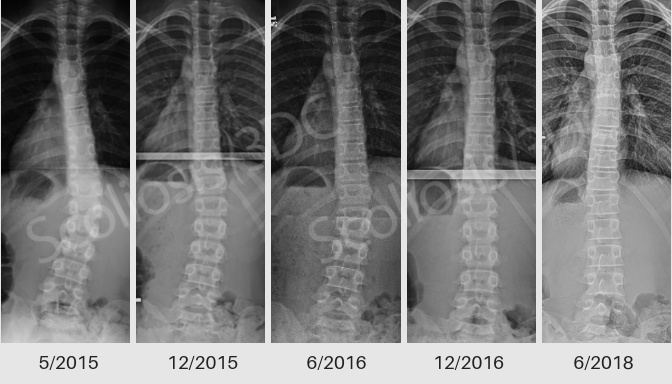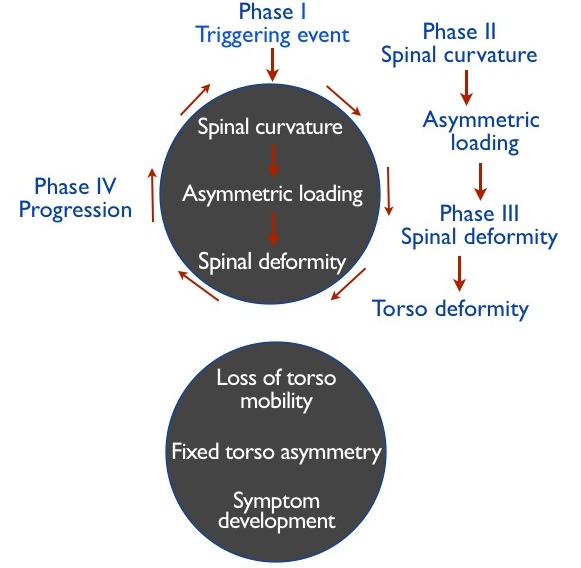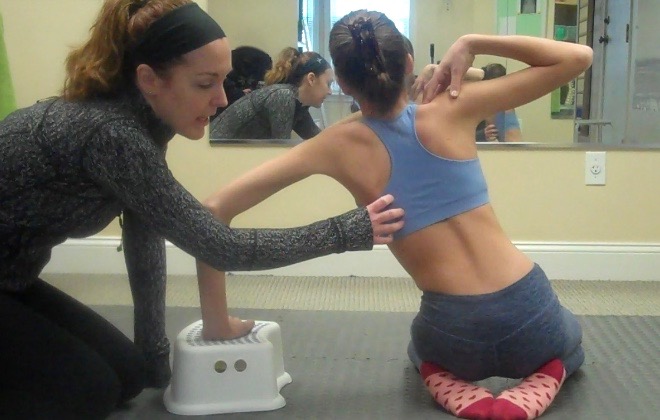
Adolescent scoliosis is a curvature of the spine (seen from side-to-side in a frontal x-ray) diagnosed between the ages of 10 and 18. About 80% of cases are considered idiopathic (no known cause) and commonly referred to as adolescent idiopathic scoliosis, or AIS for short. The remaining 20% of cases can be neuromuscular, congenital (present at birth) or syndromic (i.e. associated with other conditions such as EDS, connective tissue disorders, etc.).
Scoliosis is often first detected through a simple clinical test known as the Adam’s bend test during school screening or pediatric examination. A full spinal x-ray is required for an official diagnosis which may occur at any stage – mild, moderate or severe. The Cobb angle, as measured on x-ray, quantifies the degree/severity of scoliosis and is an important clinical marker for tracking scoliosis throughout adolescence and into adulthood.
Despite the value of the Cobb angle measurement, it is important to realize that scoliosis is a 3-dimensional condition. With scoliosis, the spine is asymmetric not only in the frontal plane, but also in the sagittal and transverse planes. The Scoliosis 3DC® program is a comprehensive management program that addresses all three planes of scoliosis with the goal of interrupting the vicious cycle and preventing curve progression.
While adolescent scoliosis treatment typically depends on age, growth potential and curve severity, significant postural imbalance and family history also play a role. At Scoliosis 3DC®, we emphasize early intervention whenever possible. Our conservative, proactive approach to adolescent scoliosis treatment differs from the status quo ‘wait and see’ advice that parents often receive.

Schroth Method for Adolescent Scoliosis
 Adolescent scoliosis is a lifelong condition that will not improve on its own and should be actively managed for the best outcome. Kids need to live in their bodies for a long time and before skeletal maturity is the only time to make a significant difference with the right treatment approach.
Adolescent scoliosis is a lifelong condition that will not improve on its own and should be actively managed for the best outcome. Kids need to live in their bodies for a long time and before skeletal maturity is the only time to make a significant difference with the right treatment approach.
Once a curve reaches 15º or more in a growing adolescent, we recommend beginning instruction in Schroth protocols to learn how to counteract asymmetric loading and curve progression. The goal of this is to unload the spinal joints and allow the spine and trunk to grow more normally.
The Scoliosis 3DC® program is based on the most effective Schroth Method protocols which have evolved during the more than 100 years of existence. Our Schroth program has been further refined based on our clinical experience with the Schroth method spanning more than twenty years! It is designed to be simpler and easier to incorporate into daily life for improved understanding and compliance. The multifaceted Scoliosis 3DC® program includes:
- Education for understanding and internalization of the curve pattern
- Scoliosis-specific activities of daily living (ADL) instruction (modified postures to self-correct while sitting, standing, etc.)
- Sagittal plane exercises/maneuvers to address the thoracic kyphosis and lumbar lordosis
- Spinal Mobilizations (to keep the spine as flexible as possible)
- Simple 3D Schroth exercises to incorporate throughout the day
- Schroth exercises designed to unload the spine and improve core muscles according to curve-pattern
- Customized video and instructional binder to refer to after program completion
- Answers to all your questions, both general and specific
- Follow-up and guidance post-program
Spinal education is the foundation of our treatment philosophy. Our programs are always individually tailored and structured so that adolescents gain a complete understanding of their unique curve pattern. A core component repeated throughout the program is ADL training, during which patients learn how to modify habitual scoliotic postures and self-correct to create a more balanced position. Not only do patients learn a personalized scoliosis-specific exercise routine, but they also learn the hows and whys of their newly modified postures, so that they know how to avoid feeding into their curve(s) when encountering new activities.
In the interest of efficiency and experiential learning, we prefer to use intensive training (over four or five days) whenever possible. This allows patients to gain a clearer understanding and have an immersive therapy experience with structure and repetition. Due to the nature of scoliosis and the potential for progression during growth, patients need to gain the necessary skills and put them to use right away, rather than prolonging instruction over weeks or months. This is why our outpatient program is designed to parallel much of the original European Schroth experience but with modern-day improvements.
Most adolescent patients complete either a 12-hour or 17-hour program (individual sessions may range from 1.5 to 2.5 hours at a time). Program recommendations will vary according to individual circumstances and based on Dr. Marc’s assessment during the examination appointment (for local patients) or a phone or Zoom consultation (for long-distance patients: please send x-rays, photos, and detailed scoliosis history to info@scoliosis3dc.com).

Potential Benefits/Goals of the Schroth Method for Adolescents
- Lifetime management skills
- Empowerment over scoliosis
- Increased strength and flexibility
- Improved breathing and lung capacity
- Improved bracing results
- Improved body awareness and body mechanics
- Postural improvement – When you think about it, it’s not your child’s x-ray that people see when they walk down the street – it’s their postural appearance. Our scoliosis exercise protocols focus on helping teens attain a more balanced, symmetrical appearance.
- Prevent curve progression (i.e. stop scoliosis from getting worse)
- *Improve Cobb angle – *This is a goal for adolescent patients but is not guaranteed and depends on individual factors. Improvement requires consistent application and is more readily achievable in immature, flexible spines.
In addition to scoliosis exercise, we offer patients the option for a fully compatible, technologically advanced, asymmetric 3D brace. We are the only US location to offer this combination treatment in one location.
Scoliosis Brace for Adolescents
At Scoliosis 3DC® we believe in providing bracing choices for adolescents with scoliosis. After more than twenty years of involvement in the conservative treatment of scoliosis, we are of the firm belief that the two best options currently available for patients are either a well-designed Chêneau brace (they do differ significantly depending on who is creating and fitting the brace) or the innovative Whisper Brace® which has made great strides for patients in terms of offering mobility for those who require, or desire, bracing.
A custom-created Chêneau TLSO brace may correct scoliosis in three dimensions and is generally Schroth method compatible. The Whisper Brace® is also custom-made, is flexible, and attempts in-brace correction through continuous corrective pressure. It also offers the added feature of Bluetooth compatibility to monitor the patient.
Bracing at Scoliosis 3DC® can be done alone or in conjunction with our Schroth exercise program. We find that patients who combine both scoliosis bracing with an effective scoliosis exercise program typically achieve the best outcomes! While the majority of our patients wear braces full-time, our scoliosis braces can also be designed for nighttime-only wear (depending on individual factors, usually for mild curves when bracing starts earlier).
When we brace a patient, our primary goals are for curve stabilization, or ideally some curve reduction, and also postural improvement in terms of reduced asymmetries resulting in better balance. Both of the braces we offer differ significantly from traditional scoliosis braces. Chêneau style braces have an asymmetric style. Each brace is designed according to an individual’s curve pattern and has strategically placed openings that allow for derotational breathing – similar to a Schroth exercise! The Whisper Brace ® also offers adjustable pressure zones for a 3-D correction effect.
Whereas most traditional scoliosis braces close in the back, both of the braces we offer have front closures. This allows for greater patient independence.
With either brace, we can brace curves ranging from the mild range (don’t wait and see) to severe curves, including those who may have been recommended for surgery. Many patients who have been told they are not eligible for other braces have achieved curve reduction after wearing and using our braces and Schroth exercise protocols. Check out our Results or our Facebook Page. We are proud to say that some of our patients have attained results that the medical profession says are impossible!
Surgery for Adolescent Scoliosis
We don’t need to tell you that spinal fusion surgery for adolescents is a serious and lasting procedure. We encourage parents to consider our proactive approach before opting for surgery. Surgery may help straighten the spine with hardware, but limits mobility and is far from a ‘quick easy fix.’
Rather than a lasting solution, for some, surgery may be the beginning of a new set of circumstances, some of which are far worse than living with scoliosis. This isn’t always the case at first, but we’ve spoken with many patients who regret their decision to have surgery, months, a year or many years later. Parents should understand that for many patients, surgery is a choice and not the requirement it is often presented as. We are not in favor of scoliosis surgery except in the most extreme cases. Please refer to our Research section for papers on the topic.
The very few patients we’ve had who eventually opted for surgery after treatment in our office (mostly cases involving neuromuscular scoliosis, congenital scoliosis, and connective tissue disorders) have reported that their surgeons were pleased with recovery times and had outcomes that exceeded expectations. That said, we’ve had many adolescent scoliosis patients who were previously recommended for surgery who have been able to avoid surgery.
Post-surgical Scoliosis Treatment
It is important to realize and accept that scoliosis is a lifelong condition that may require maintenance even after surgery. After spinal fusion surgery, the spine can sometimes buckle above and below fusion sites (i.e. causing compensatory curves to progress). Pain levels can also increase in adulthood. In these cases, post-surgical patients may be candidates for our Schroth program and/or part-time bracing to help mitigate post-surgical symptoms. To participate in our program after surgery, patients must be 1-year post-operation with recent PA and lateral x-rays indicating stable hardware. Clearance from an orthopedic surgeon may also be required.
Whether you’re looking to help your adolescent child avoid scoliosis surgery, or are seeking post-surgical treatment, please contact us with more details.
¹ Moramarco M, Moramarco K, Fadzan M. Cobb Angle Reduction in a Nearly Skeletally Mature Adolescent (Risser 4) After Pattern-Specific Scoliosis Rehabilitation (PSSR). The Open Orthopaedics Journal. 2017;11:1490-1499. doi:10.2174/1874325001711011490.

